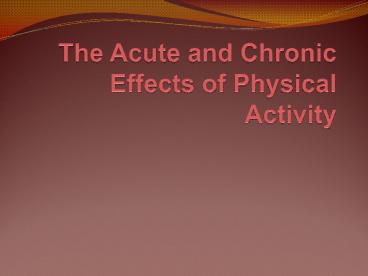The Acute and Chronic Effects of Physical Activity PowerPoint PPT Presentation
1 / 17
Title: The Acute and Chronic Effects of Physical Activity
1
The Acute and Chronic Effects of Physical Activity
2
Acute Response to Exercise
- The sudden, temporary changes in body function
caused by exercise. - They disappear shortly after the exercise period
is finished.
3
Chronic Adaptation to Exercise
- Persistent changes in the structure and function
of your body following regular exercise. - Changes that enable your body to respond more
easily to exercise
4
Physiological Responses to Acute Exercise
- Acute responses to exercise are influenced by a
number of factors - Level of training or fitness status
- Sufficiency of sleep
- Coffee intake
- Alcohol
- Tobacco
- General anxiety
5
Increase in Heart rate
- The pre-exercise heart rate may be elevated due
to the anticipatory response. - During the GXT, heart rate will increase in
direct proportion to the intensity of the
exercise. - HR rises in a linear fashion with increases
workload. - At exhaustion the rise in HR will flatten out.
This is called the maximal heart rate. - At this point the rise in HR becomes more
curvilinear and will not increase further.
6
(No Transcript)
7
Increase of Stroke Volume
- SV is the quantity of blood pumped out of the
heart per heart beat. - SV is regulated by
- Amount of venous return to the heart.
- The force of contraction of the heart muscle.
- Sympathetic nervous stimulation.
- The change in SV during a GXT does not follow the
pattern of change in heart rate. - SV increases strongly up to 40-60 of V02max.
- Beyond this intensity level, increasing workload
brings only small increase in SV.
8
Stroke Volume
- Resting SV values for sedentary people range
between 60 and 70 ml of blood per heart beat. - Highly trained people may have resting SV values
as high as 100ml. - Submaximal and maximal SV volumes are also higher
for fit than sedentary people. - SV for elite runners have been measured as high
as 180ml/beat.
9
Body Position Effects SV
- When you go from lying down to standing there is
an immediate drop in your SV. - This is because of the influence in gravity and a
corresponding increase in your heart rate to
maintain the flow of blood out of your heart. - When exercise is performed in a horizontal
position (swimming), the SV is larger and the HR
is lower than when the same level of upright
exercise is performed (running). - Exercise training HRs should be adjusted
downward by 10-15 BPM when swimming.
10
(No Transcript)
11
Increase in Cardiac Output
- Q SV x HR ( quantity of blood pumped out of
the heart each minute) - At rest, Q is approximately 5 liters
- During maximal exercise it can rise to 20-40
liters per minute, depending on individual
fitness level and body size. - Q rises linearly with increasing workload and
plateaus slightly at exer. exhaustion. - Initially the increase is due to both HR and SV
increasing. After 40-50 of V02 max, it is due
to increased heart rate.
12
Increased Arteriovenous Oxygen Difference
- a-v02 the difference between the amount of
oxygen carried in the arterial blood and the
amount in the mixed venous blood. - The a-v02 reflects the amount of oxygen extracted
by the tissues of the body. - At rest, the 02 content of arterial blood is
approximately 20 ml of oxygen per 100 ml of
blood, compared to an 02 content of 15ml/100
blood for the mixed venous blood. - The a-v02 difference at rest is 5 ml/100ml blood.
- During intense exercise, the venous oxygen
content can drop to 2 to 4 ml/100ml blood. - The a-v02 diff. can increase to 16-18ml/100ml
blood.
13
Increase in V02
- V02max the greatest rate at which oxygen can be
consumed during exercise at sea level. - During GXT, active muscle tissue uses more and
more oxygen to burn CHOs and fats needed for
energy production. - For every liter of oxygen consumed, about 5
calories of energy are produced.
14
V02 Max
- If Q and the a-v02 difference are known, oxygen
consumption can be calculated by using the
formula V02 Q x a-v02.
15
(No Transcript)
16
Oxygen Debt/Deficit
- 02 debt refers to the volume of oxygen consumed
during the recovery period following exercise in
excess of the volume normally consumed at rest. - This debt pays back the deficit built up during
the initial minutes of exercise, on account of
the body adjusting to the exercise. - During the first 2-3 minutes of exercise, your
body is adjusting to the new workload. During
recovery, you will breathe harder than during
rest to help restore this deficit to normal.
17
(No Transcript)

